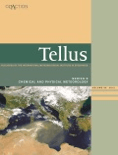
TELLUS SERIES B-CHEMICAL AND PHYSICAL METEOROLOGY
Scope & Guideline
Pioneering open-access research in meteorological sciences.
Introduction
Aims and Scopes
- Atmospheric Chemistry and Aerosols:
Research on the composition, sources, and impacts of atmospheric aerosols, including studies on non-sea-salt aerosols, black carbon, and their interaction with meteorological factors. - Boundary Layer Meteorology:
Investigation into the planetary boundary layer and its influence on atmospheric states, including effects on pollutants, weather patterns, and local climate. - Climate Change and Environmental Impacts:
Exploration of the effects of industrial activity and climate change on atmospheric conditions, focusing on variables like ozone, carbon uptake, and ocean acidification. - Satellite and Remote Sensing Techniques:
Utilization of satellite-derived data to analyze cloud properties, aerosol distributions, and atmospheric dynamics through advanced statistical and modeling approaches. - Modeling and Simulation:
Development and application of models for simulating atmospheric processes, including gas transfer dynamics, cloud microphysics, and vegetation-atmosphere interactions.
Trending and Emerging
- Machine Learning Applications in Meteorology:
The use of machine learning techniques to analyze meteorological data and improve understanding of cloud microphysical properties and aerosol impacts is on the rise, indicating a trend towards integrating artificial intelligence in atmospheric sciences. - Impact of Industrial Activities on Atmospheric Conditions:
Research exploring the effects of industrial activities on atmospheric composition, particularly regarding oxygen levels and aerosol loading, has gained prominence, emphasizing the interaction between human activities and the environment. - Climate Interactions with Natural Aerosols:
Emerging studies on the spatio-temporal distributions of natural aerosols and their climatic implications reflect a growing interest in understanding natural processes and their contributions to atmospheric phenomena. - Real-time Monitoring and Innovative Sampling Techniques:
The development of new methodologies for high-resolution sampling and monitoring of atmospheric conditions, including chemical composition of fog and aerosol dynamics, signifies a trend toward real-time data collection and analysis. - Interactive Vegetation-Atmosphere Dynamics:
Research focusing on the interactive roles of vegetation in the atmosphere, such as leaf phenology and its climatic effects, is gaining traction, highlighting the importance of ecological interactions in meteorology.
Declining or Waning
- Historical Ozone and Trace Gas Studies:
Research related to the historical analysis of ozone and trace gases has seen reduced emphasis, possibly due to a shift towards more immediate environmental issues and real-time data analysis. - Long-term Variability Studies:
Investigations centered on long-term variability of atmospheric parameters, such as ozone levels and aerosol measurements, appear to be waning, possibly due to a growing preference for studies that incorporate modern techniques and immediate relevance. - Societal Implications of Climate Change Education:
While initially gaining traction, discussions on the role of higher education in building climate change competencies have diminished, reflecting a potential shift towards more technical and empirical research.
Similar Journals

ADVANCES IN ATMOSPHERIC SCIENCES
Exploring New Horizons in Atmospheric DynamicsADVANCES IN ATMOSPHERIC SCIENCES is a highly esteemed journal published by SCIENCE PRESS, dedicated to advancing the field of atmospheric sciences. With an impressive impact factor and ranking as Q1 in Atmospheric Science as of 2023, this journal serves as a leading platform for researchers, professionals, and students to disseminate substantial findings and innovative methodologies across various topics within the atmospheric sciences domain. Established in 1984 and continuously publishing through to 2024, it has successfully positioned itself among the top ranks, currently standing at #17 out of 148 in the Scopus category, highlighting its significance in the field with a remarkable 88th percentile. Although it operates under traditional access, the journal provides invaluable insights into climate dynamics, meteorology, and environmental processes that are crucial for both academic and practical applications. Based in Beijing, China, ADVANCES IN ATMOSPHERIC SCIENCES is committed to fostering a global dialogue and collaboration among scholars and industry experts, making it an essential resource for those invested in understanding and addressing contemporary atmospheric challenges.

Asia-Pacific Journal of Atmospheric Sciences
Navigating the Complexities of Climate ChangeWelcome to the Asia-Pacific Journal of Atmospheric Sciences, a leading publication in the field of atmospheric science, published by the Korean Meteorological Society. With an ISSN of 1976-7633 and an E-ISSN of 1976-7951, this journal has been a cornerstone for researchers and practitioners in the atmospheric sciences since its inception in 2008. Recognized for its rigorous peer-reviewed articles, it holds a commendable Q2 quartile ranking in 2023 and is placed at the 51st rank out of 148 in the Earth and Planetary Sciences, reflecting its impact within the community with a 65th percentile. The journal features a broad scope encompassing meteorology, climatology, and environmental sciences, making it an essential resource for scholars and industry experts alike. As an open access journal, it ensures that groundbreaking research is widely accessible, fostering collaboration and innovation across the Asia-Pacific region and beyond. Explore the latest findings and advancements in atmospheric sciences and contribute to the dynamic field of climate research through the journal's engaging content.
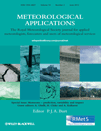
METEOROLOGICAL APPLICATIONS
Connecting Experts to Enhance Weather UnderstandingMETEOROLOGICAL APPLICATIONS is an esteemed journal published by WILEY that has been a vital resource in the field of atmospheric science since its inception in 1994. With an Impact Factor indicative of its credibility and influence in the academic community, the journal has notably achieved a Q2 ranking in the 2023 category quartiles for Atmospheric Science, demonstrating its commitment to advancing knowledge in meteorology. As an Open Access journal since 2020, it provides widespread accessibility to researchers, professionals, and students, promoting collaborative efforts in the pursuit of innovative solutions to atmospheric challenges. With its dedicated focus on interdisciplinary studies in meteorology, METEOROLOGICAL APPLICATIONS serves as a crucial platform for sharing cutting-edge research and fostering dialogue among experts, thereby enhancing our understanding of weather phenomena and their global impacts. For submissions and accessing articles, the journal can be found at WILEY’s headquarters in Hoboken, NJ, representing a hub for scholarly discourse in the atmospheric sciences.

Atmospheric Measurement Techniques
Revolutionizing Atmospheric Measurements for Global Impact.Atmospheric Measurement Techniques, published by COPERNICUS GESELLSCHAFT MBH, is a premier open-access journal that has been contributing to the field of atmospheric science since 2008. With its focus on advancing techniques for atmospheric observations and measurements, the journal has established itself as an authoritative source with a Q1 ranking in the Atmospheric Science category for 2023, placing it among the top journals in the field. Based in Germany, its commitment to accessibility ensures that researchers, professionals, and students can freely engage with high-quality research that influences environmental monitoring, climate studies, and atmospheric modeling. As of 2023, it successfully ranks 32nd out of 148 in Earth and Planetary Sciences—demonstrating its significant impact in the scientific community with a commendable 78th percentile status within this dynamic domain. Researchers focusing on innovative atmospheric measurement techniques will find this journal a vital platform for disseminating their findings and collaborating on cutting-edge research.
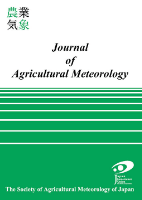
JOURNAL OF AGRICULTURAL METEOROLOGY
Empowering Farmers with Meteorological Wisdom.JOURNAL OF AGRICULTURAL METEOROLOGY, published by the Société Agronomic Meteorology Japan, stands as a prestigious platform in the fields of Agronomy and Atmospheric Science, with a rich history dating back to its inception in 1943. This journal, identifiable by its ISSN 0021-8588 and E-ISSN 1881-0136, is committed to advancing the understanding of the interrelationships between agriculture and meteorological phenomena. Positioned in the Q2 quartile in Agronomy and Crop Science and Q3 in Atmospheric Science as of 2023, it reflects a solid impact within its domains. Although it does not currently operate under an Open Access model, its publication delivers high-quality research that significantly contributes to the improvement of agricultural practices and meteorological predictions. With a focus on empirical studies and innovative methodologies, this journal serves as an essential resource for researchers, professionals, and students aiming to address pressing agricultural challenges influenced by climatic conditions. The Journal of Agricultural Meteorology not only informs but also inspires collaboration and knowledge sharing in the ever-evolving landscape of agricultural meteorology.
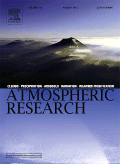
Atmospheric Research
Fostering Innovation in Meteorological StudiesAtmospheric Research is a premier journal published by Elsevier Science Inc, specializing in the field of Atmospheric Science. With a commendable impact factor, it holds a distinguished position in the Scopus rankings, being placed 14th out of 148 journals within its category and achieving a remarkable 90th percentile rank. This journal serves as a vital outlet for rigorous research on atmospheric processes, climate variability, and meteorological phenomena, providing a platform for scientists, researchers, and students to disseminate their findings and contribute to the advancement of knowledge in this critical field. Although it is not an open-access journal, its strong reputation and selective publication criteria ensure that only high-quality and impactful studies are featured. Since its inception in 1986, Atmospheric Research has continuously evolved to meet the dynamic nature of atmospheric studies, making it a fundamental resource for anyone engaged in understanding and addressing atmospheric challenges worldwide.

Advances in Climate Change Research
Innovating Solutions for a Changing PlanetAdvances in Climate Change Research is a premier open-access journal dedicated to advancing the understanding of climate change and its wide-ranging impacts on our planet. Published by KEAI PUBLISHING LTD since 2010, it has established itself as a leading forum for research in Atmospheric Science, Global and Planetary Change, and Environmental Management, achieving a notable Q1 ranking across these categories as of 2023. The journal, which operates out of Beijing, China, ensures that researchers, professionals, and students have unrestricted access to cutting-edge studies, enhancing global knowledge on climate change mitigation and policy development. With impressive Scopus rankings, including 11th out of 148 in Atmospheric Science, it represents a vital resource for those seeking to contribute to climate science and its applications. By submitting your work to this influential journal, you join a global community committed to addressing one of the most pressing challenges of our time.

TELLUS SERIES A-DYNAMIC METEOROLOGY AND OCEANOGRAPHY
Exploring the Dynamics of Climate and Marine SystemsTELLUS SERIES A-DYNAMIC METEOROLOGY AND OCEANOGRAPHY, published by Stockholm University Press, is a prestigious open-access journal that has been at the forefront of research in the fields of atmospheric science and oceanography since its inception in 1983. With an enduring commitment to disseminating high-quality, peer-reviewed research, the journal has achieved a commendable impact factor, securing its position in the Q2 category for both Atmospheric Science and Oceanography as of 2023. The journal's significant reach is reflected in its Scopus rankings, being positioned at Rank #51 in Oceanography and Rank #77 in Atmospheric Science. With open access established since 2012, TELLUS SERIES A serves not only as a vital resource for researchers and professionals in these dynamic fields but also as an inclusive platform for budding scholars and students. Engaging with this journal allows readers to stay updated on the latest developments and groundbreaking discoveries that advance our understanding of climate systems and marine environments. Its editorial ethos emphasizes the cross-disciplinary integration of atmospheric and oceanographic studies, making it an essential publication for anyone invested in environmental research and policy.

BULLETIN OF THE AMERICAN METEOROLOGICAL SOCIETY
Transforming insights into action for a resilient planet.BULLETIN OF THE AMERICAN METEOROLOGICAL SOCIETY, published by the American Meteorological Society, stands as a premier forum in the field of meteorology and atmospheric science, boasting an impressive ranking in the Q1 category for 2023. With a long-standing history dating back to 1972, this journal serves as a vital resource for researchers, practitioners, and students dedicated to advancing the understanding of atmospheric phenomena. The journal facilitates the dissemination of cutting-edge research, innovative methodologies, and significant findings that propel the scientific community forward. Although not an Open Access journal, it remains a critical publication for comprehending complex environmental interactions, climate change, and weather-related phenomena. The BULLETIN OF THE AMERICAN METEOROLOGICAL SOCIETY is essential reading for anyone invested in atmospheric sciences, providing invaluable insights that shape policy, enhance safety, and promote environmental sustainability.
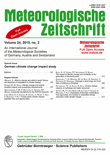
METEOROLOGISCHE ZEITSCHRIFT
Advancing Knowledge in Meteorology and Atmospheric SciencesMETEOROLOGISCHE ZEITSCHRIFT is a distinguished academic journal dedicated to the field of meteorology and atmospheric sciences, published by E SCHWEIZERBARTSCHE VERLAGSBUCHHANDLUNG. With an ISSN of 0941-2948 and an E-ISSN of 1610-1227, this journal has been an invaluable resource for researchers, professionals, and students since its inception. It has embraced an Open Access model since 2014, promoting wider dissemination of research findings. Based in Stuttgart, Germany, the journal is recognized for its rigorous peer-review process and is currently positioned in the Q3 quartile for Atmospheric Science as per the 2023 category rankings. Additionally, it ranks #97 out of 148 in the Scopus database, placing it in the 34th percentile among Earth and Planetary Sciences. Covering a broad spectrum of topics relevant to meteorology, METEOROLOGISCHE ZEITSCHRIFT serves as a platform for innovative research and theoretical contributions, aiming to advance understanding of atmospheric phenomena and their implications for climate and weather. Researchers and practitioners alike will find valuable insights within its pages, making it a significant asset in the landscape of meteorological scholarship.